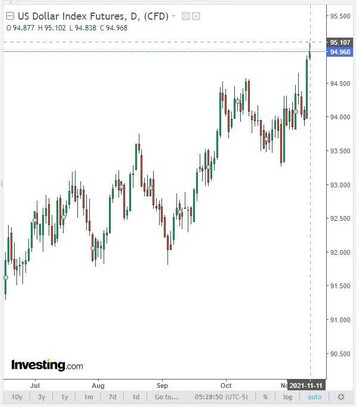On Wednesday, oil prices dropped quite sharply. This is how the participants of the oil market reacted to the information about the growth of oil reserves in the US last week, as well as to the strengthening of the dollar.
As reported yesterday in the Energy Information Administration (EIA) of the US Department of Energy, oil reserves in the week of October 30 - November 5 increased by an amount less than forecast, by 1 million barrels, to 435.1 million barrels (the forecast assumed an increase in oil reserves by 1.3 million barrels). At the same time, US oil reserves remain about 7% below the 5-year average, which is a moderately positive factor for oil quotes. At the same time, stocks of gasoline and other petroleum products decreased more than expected.
However, oil prices fell on Wednesday. So, futures for WTI crude oil fell by 3.7%, or $ 3.5, to $ 80.13 per barrel.

The main reason for this was the sharp strengthening of the dollar. It rose to a 15-month high yesterday against other currencies and the DXY dollar index rose 0.2% to 94.90, its highest level since late July 2020, and today DXY futures are attempting to rally above 95.10. Now market participants are putting in quotes a higher probability of an increase in interest rates in the United States in 2022. The reason for the revision of market expectations was the inflation data presented on Wednesday.
The US consumer price index (CPI) released yesterday jumped 6.2% (y / y) in October, the strongest growth in more than 30 years. The forecast was +5.8% after rising +5.4% in September. The core CPI, which excludes volatile food and energy prices, rose +0.6% and +4.6% compared to October last year. This is the largest increase in base prices since 1991.
The Federal Reserve Board continues to believe that the acceleration in inflation will be temporary. But inflation in the US, peaking in more than 30 years, has heightened investor fears about price pressures in the global economy. Higher-than-expected inflation data raise the likelihood of a tightening of the Fed's policy.
Meanwhile, according to data from the US Department of Labor, also published on Wednesday, the number of initial applications for unemployment benefits fell to 267 thousand compared with 271 thousand a week earlier, which is in line with pre-crisis levels.
Now investors are wondering not only whether the Fed will start raising interest rates as early as next year, but also about the timing and scope of this increase.
Meanwhile, in October, energy prices showed one of the most significant monthly gains, climbing 4.8%. Gasoline prices rose 6.1%, while utility gas prices rose 6.6%. The rise in prices was also observed against the backdrop of a recovery in economic activity around the world after the easing of coronavirus restrictions. Oil quotes are up more than 70% since the beginning of the year, and gasoline prices in the US for the year rose to $ 3.40 a gallon from $ 2.12 a gallon.
In an October monthly report from the International Energy Agency (IEA), skyrocketing natural gas and coal prices are driving up demand for oil from power plants and manufacturing industries. Amid the ongoing energy crisis, oil demand may increase by 500,000 barrels per day in the coming months, IEA analysts said.
“The acute shortage of natural gas, LNG and coal amid the global economic recovery has triggered skyrocketing energy prices and a large-scale transition to the use of oil and petroleum products for power generation”, the IEA said.
Now, oil market participants will pay attention to the publication on Friday (at 17:00 GMT) of the weekly report on oil platforms from the oilfield services company Baker Hughes. Previous data from Baker Hughes reflected an increase in the number of active rigs to 450 units (versus 445, 433, 428, 421, 411, 401, 394, 410, 405, 397 in previous reporting periods). It is obvious that the number of oil companies in the US is growing again, which is a negative factor for oil prices. Their next growth will also have a negative impact on oil quotes, however, it will only be of a short-term nature.
In general, despite yesterday's decline, oil market analysts believe that energy prices will remain at current levels and higher, and the situation may worsen during the cold winter period, although there is no global oil shortage, despite limited oil supplies by OPEC+ countries.
Today, November 11, is a national holiday in the United States on the occasion of Veterans Day; banks will be closed, but the stock markets on the NYSE and NASDAQ are open on this day. Trading on the CME exchange, where the most liquid futures and options contracts (for example, S&P futures or WTI oil futures) are traded, will also be held as usual. In the US, bond markets will be closed.





